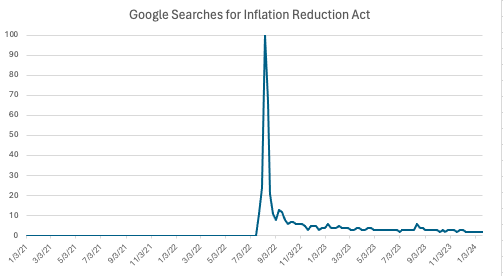Here’s a modest and basic account of democracy: While they seek office, candidates make proposals. Voters select the politicians with the proposals they prefer. The winners try to implement their ideas. Voters observe, discuss, and evaluate what happens. In the next election, voters decide whether to stay or change the course.
In 2020, Joe Biden and congressional Democrats ran on a fairly clear platform of spending money to stimulate green manufacturing in disadvantaged places. They then managed to pass the $1.9 trillion American Rescue Plan, the $739 billion Inflation Reduction Act, and the $280+ billion CHIPS Act. The total was less than some of them had proposed, but it was more than I had expected, considering that congressional Republicans were also elected who opposed these ideas.
The net effect is not only a significant change in policy but also a turn of the steering wheel. We’re now at the beginning of a long journey toward a green industrial policy.
In 2024, the voters will–as they should–determine whether to stay on this route or hit the breaks. But they will not make a conscious decision. The federal budget will not be a decisive issue, or perhaps even a prominent one. Whether the country shifts to an industrial policy will be an unrecognized side-effect of votes cast for other reasons.
Biden does not seem likely to emphasize the federal spending because it doesn’t poll well. Perhaps that’s partly because voters (including liberal ones) do not believe what Democratic incumbents claim about their own policy successes. Instead, Biden will run on Trump’s unfitness, Jan. 6, and abortion, and he may well win on that basis.
Trump will not run against the federal spending because he has other grievances on his mind. Besides, he does not really oppose ambitious and expensive federal interventions. The rest of his party will take pot shots at the deficit but not challenge the spending because doing so would concede that the Democrats have made substantial changes. They prefer depicting Biden as feckless rather than wrong.
And the press won’t cover the spending because its results are not yet very tangible, and it no longer qualifies as a live political conflict. As a rough proxy for press attention, consider the trend in Google searches for “Inflation Reduction Act” since 2020. The current rate is one fiftieth of the brief peak that occurred while the Act was political news.

I favor the Biden-era policies. I understand principled arguments against them from several directions. We should be debating green industrial policy and deciding whether or not to continue this course.
One reason we will miss this debate is that Donald Trump has given us other grave matters to discuss. Indeed, it would be problematic if voters failed to consider the threat he poses to the constitution. But I don’t think Trump is the only reason. The failure of a major ideological change to register on the public consciousness is symptomatic of a breakdown in news, attention, and public discussion that prevents the people from controlling our government.
See also: preparing for a possible Trump victory; a presidential election with two incumbents?; 1984 all over again? The Reagan/Biden analogy; whether to make the election a referendum on MAGA
